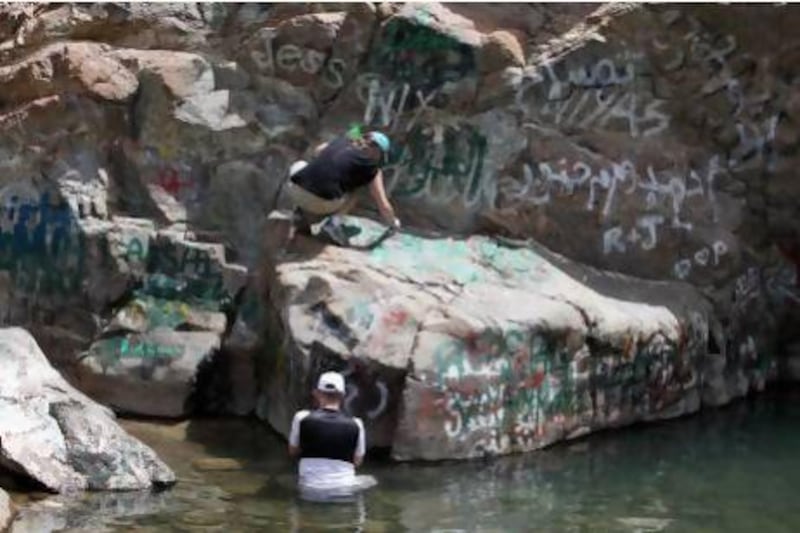ABU DHABI // With its deep rocky gorges and flowing water pools filled with freshwater fish, Wadi Wurayah is not only a scenic spot but a complex ecosystem in need of protection.
While many steps have been taken in the past few years to preserve its 500 species of rare animals and plants, a clean-up campaign yesterday showed the site to be facing a rather prosaic challenge - litter.
"Still people are picnicking and leaving their rubbish behind," said Moaz Al Sawaf, project manager at the Emirates Wildlife Society - World Wide Fund for Nature (EWS-WWF).
Together with Fujairah Municipality, the organisation gathered more than 100 volunteers at the Wadi Wurayah national park yesterday to clean several areas, including the waterfall and freshwater pools in the heart of the wadi.
The volunteers' rubbish bags, collected by waste management company Dulsco, contained plastic bags, bottles, plates, disposable cutlery, styrofoam cups, aluminium foil food containers and beverage cans.
"I can see the awareness level [of visitors] is increasing," said Mr Al Sawaf, who has been studying the area for decades. "But it is still not where we would like to see it.
"It is a lot [of waste] and most of it in places you do not see, such as the small galleys and corridors."
He said that while people usually camp in the main wadis and leave their rubbish there, annual rains and flash floods spread the debris over large distances.
About 90 per cent of the waste collected yesterday was plastic said Mr Al Sawaf, who has also been finding plastic debris in the droppings of rare mountain animals.
"Quite a few times I have found pieces of plastic bags, forks and other items that the animals seemed to have eaten," he said.
Among the volunteers yesterday was Lisa Banfield, 35, a conservation officer at Al Ain Zoo, who was taking part in the clean-up with four colleagues.
"It is very beautiful, apart from the graffiti and the rubbish," she said. "I do not understand why you would come to an area like this and leave it in such a state for other people."
Hannah McGinty was one of eight staff from Linklaters, an international law firm with an office at DIFC.
"This is a beautiful, stunning location but it is a shame it has been wrecked by so many people throwing litter and spraying graffiti," she said.
The 30-year-old spent the morning picking up litter before moving to the wadi's main pools to clean graffiti sprayed on the rocks, which required some effort.
"It is not very easy to shift, it depends on the type of paint," she said, brushing vigorously.
For the volunteers, the clean-up was also a chance to enjoy a beautiful, natural spot.
"While volunteering with EWS, I saw pictures of the wadi and learnt about it," said Kehkashan Basu, 12, who was there with her mother, Swati.
Kehkashan was sent to clean a rocky valley far from the waterfall area but she was upbeat about the task.
"It is amazing," said her friend, Komal Muthyalu, 13, scanning the acacia-tree covered valley as her brother Kaushik, 16, and mother, Purnima, looked on. "We are going to enjoy ourselves."





